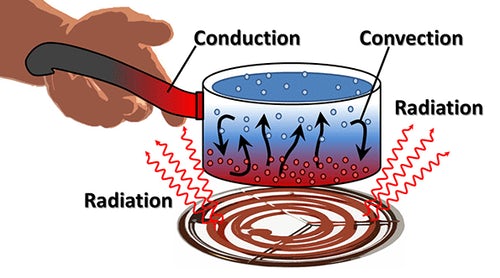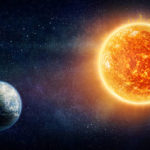Before we continue our discussion on how heat affects our environments, let’s explore how heat is transferred from one object to another. There are three natural processes that can be used to transfer heat. These processes are called radiation, conduction, and convection.
Radiation
All objects radiate energy and heat, even your own body. However, the radiation coming from hotter objects is more intense than that coming from cooler objects. Radiation leaves an object in the form of waves. The hotter an object, the shorter the wavelength of this radiation.
As you stand in front of a camp fire holding your cold fingertips out in front of you, what do you feel? Slowly your fingers begin to warm up as they absorb the radiation coming from the fire. The infrared waves, or heat rays, leave the hot fire, and radiate out towards your hands.
An object that is especially good at radiating heat is referred to as a blackbody. Both the Sun and the Earth are excellent radiators, and as a result, both are considered blackbodies.
Conduction
Heat can also be transferred from one object to another, or from one molecule to another through the process of conduction. As one molecule is heated it begins to move and shake rapidly. As it does so, it passes some of its heat energy to other molecules around it. Through this process, all the molecules of an object pass heat from one to another until they are all hot.
Returning to the example of a camp fire: What happens if we use an old metal hanger to roast hotdogs? As the hotdog cooks, the fire heats the end of the hanger. If we leave the hanger in the fire long enough, eventually the end we are holding will become too hot for us to handle. This happens despite the fact that this end was never placed into the flames. Heat was transferred from the flames to the metal, and then from molecule to molecule in the hanger via conduction until it reached your sensitive fingers.
Not all objects are good conductors of heat. In our example above, what would happen if you had chosen a stick to roast your hotdog on instead of a metal hanger? Though the stick may have caught fire, it would not have conducted the heat to your hand. This is because wood is a very poor heat conductor.
Convection
The final way that heat is transferred from one place to another is convection. Convection takes place when heated molecules move from one place to another, taking the heat with them. Convection is common in both the atmosphere as well as in the oceans.
Heated air in our atmosphere expands, becoming less dense. Because it is less dense, it rises upward. Cooler air rushes in to replace the air that lifted up. As warm air rises and cool air falls, a giant circular pattern is created. Eventually the warmer air cools and begins to fall again.
Convection also takes place within the Sun. Vast amounts of hot gas rise up towards the surface of the Sun. As they do so, they become cooler and begin to fall back down towards the center of the Sun. As they do so, they again heat up and begin rising again, over and over, rising and falling in a seemingly eternal circular pattern.






